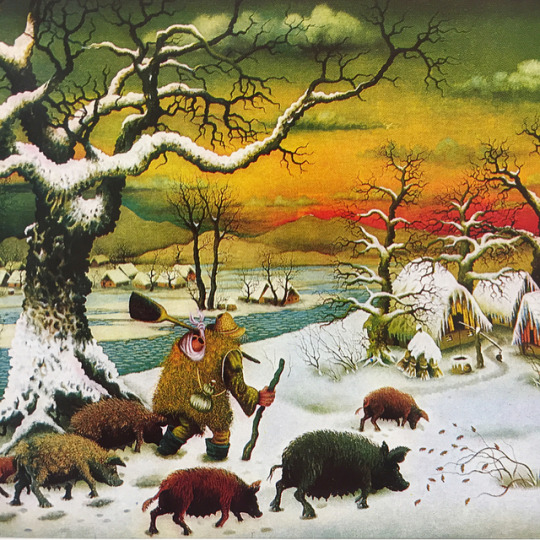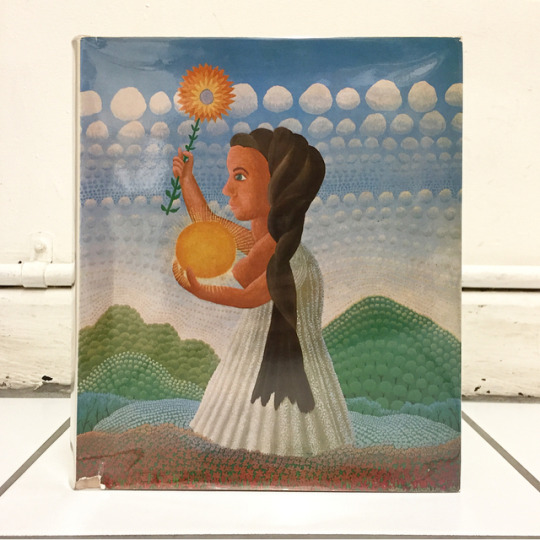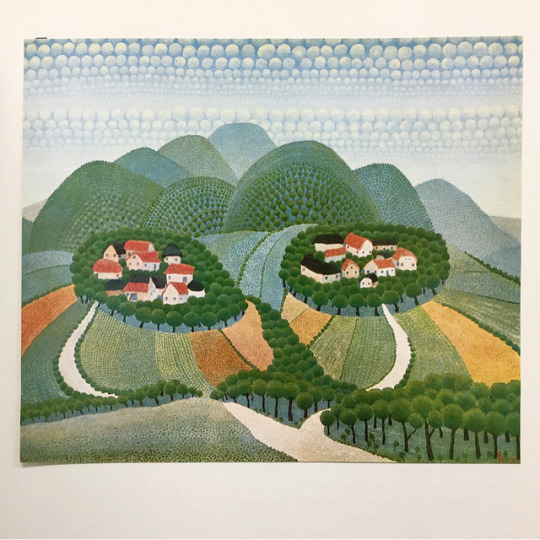#boriskelemen
Photo

NEW IN THE BOOKSHOP: YUGOSLAV NAÏVE PAINTING (1969) • Published by Galerije Grada Zagreba, Zabreb, in 1969, this handsome hardcover forms a comprehensive study of Yugoslav Niave Painting by author Boris Kelemen, profiling the work of Emerik Feješ, Franjo Filipović, Dragan Gaži, Ivan Generalić, Josip Generalić, Bosilj Ilija (Ilija Bašičević), Mijo Kovačić, Franjo Mraz, Vangel Naumovski, Ivan Rubazin, Matija Skurjeni, Ivan Večenaj, Stjepan Vecenaj, and Mirko Virius through full-colour tipped-in plates. • Naïve, or primitive art is a distinct segment of the art of the 20th century. In Croatia, naïve art was at first connected with the works of peasants and working people, ordinary men and women, self-taught, of whom the most successful, over the course of time, became professional artists. An identifiably individual style and poetic nature distinguishes the Naïve from other "amateur" painters and sculptors, often displaying unusual proportions and perspective, and certain illogicalities of form and space. Such characteristics are the expression of a free creative imagination, in a similar way to other 20th-century art movements such as Symbolism, Expressionism, Cubism, and Surrealism. Naïve art first appeared in Croatia at the beginning of the 1930s when the Zagreb Art Pavilion showcased an exhibition of the artists' association entitled Country (Zemlja) on 13 September 1931. The artists sought to show that talent does not only reside in certain social classes or privilege and started the association with naïve art and paintings of villages or by artists from the countryside rather than cities. • One copy via our website and in the bookshop. • #worldfoodbooks #yugoslavnaivepainting #1969 #boriskelemen (at WORLD FOOD BOOKS)
16 notes
·
View notes
Photo

NEW IN THE BOOKSHOP: YUGOSLAV NAÏVE PAINTING (1969) • Published by Galerije Grada Zagreba, Zabreb, in 1969, this handsome hardcover forms a comprehensive study of Yugoslav Niave Painting by author Boris Kelemen, profiling the work of Emerik Feješ, Franjo Filipović, Dragan Gaži, Ivan Generalić, Josip Generalić, Bosilj Ilija (Ilija Bašičević), Mijo Kovačić, Franjo Mraz, Vangel Naumovski, Ivan Rubazin, Matija Skurjeni, Ivan Večenaj, Stjepan Vecenaj, and Mirko Virius through full-colour tipped-in plates. • Naïve, or primitive art is a distinct segment of the art of the 20th century. In Croatia, naïve art was at first connected with the works of peasants and working people, ordinary men and women, self-taught, of whom the most successful, over the course of time, became professional artists. An identifiably individual style and poetic nature distinguishes the Naïve from other "amateur" painters and sculptors, often displaying unusual proportions and perspective, and certain illogicalities of form and space. Such characteristics are the expression of a free creative imagination, in a similar way to other 20th-century art movements such as Symbolism, Expressionism, Cubism, and Surrealism. Naïve art first appeared in Croatia at the beginning of the 1930s when the Zagreb Art Pavilion showcased an exhibition of the artists' association entitled Country (Zemlja) on 13 September 1931. The artists sought to show that talent does not only reside in certain social classes or privilege and started the association with naïve art and paintings of villages or by artists from the countryside rather than cities. • One copy via our website and in the bookshop. • #worldfoodbooks #yugoslavnaivepainting #1969 #boriskelemen (at WORLD FOOD BOOKS)
0 notes
Photo

NEW IN THE BOOKSHOP: YUGOSLAV NAÏVE PAINTING (1969) • Published by Galerije Grada Zagreba, Zabreb, in 1969, this handsome hardcover forms a comprehensive study of Yugoslav Niave Painting by author Boris Kelemen, profiling the work of Emerik Feješ, Franjo Filipović, Dragan Gaži, Ivan Generalić, Josip Generalić, Bosilj Ilija (Ilija Bašičević), Mijo Kovačić, Franjo Mraz, Vangel Naumovski, Ivan Rubazin, Matija Skurjeni, Ivan Večenaj, Stjepan Vecenaj, and Mirko Virius through full-colour tipped-in plates. • Naïve, or primitive art is a distinct segment of the art of the 20th century. In Croatia, naïve art was at first connected with the works of peasants and working people, ordinary men and women, self-taught, of whom the most successful, over the course of time, became professional artists. An identifiably individual style and poetic nature distinguishes the Naïve from other "amateur" painters and sculptors, often displaying unusual proportions and perspective, and certain illogicalities of form and space. Such characteristics are the expression of a free creative imagination, in a similar way to other 20th-century art movements such as Symbolism, Expressionism, Cubism, and Surrealism. Naïve art first appeared in Croatia at the beginning of the 1930s when the Zagreb Art Pavilion showcased an exhibition of the artists' association entitled Country (Zemlja) on 13 September 1931. The artists sought to show that talent does not only reside in certain social classes or privilege and started the association with naïve art and paintings of villages or by artists from the countryside rather than cities. • One copy via our website and in the bookshop. • #worldfoodbooks #yugoslavnaivepainting #1969 #boriskelemen (at WORLD FOOD BOOKS)
0 notes